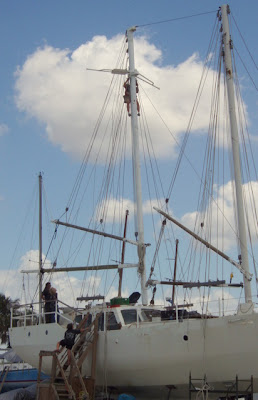Deck Repairs & Heights
With a project such as ours, one has to be prepared to deal with things as they come up.
 Welding a stress crack in the gunwale adjacent to the chainplate. Important stuff here, but much easier to remedy in steel than in any other medium. Even a critical repair such as this could be done underway in a self sufficient boat like Free Spirit.
Welding a stress crack in the gunwale adjacent to the chainplate. Important stuff here, but much easier to remedy in steel than in any other medium. Even a critical repair such as this could be done underway in a self sufficient boat like Free Spirit.
 Putting the finishing touches on the chainplate repair.
Putting the finishing touches on the chainplate repair.
We do not have it photo documented, but Tamer also had to replace sections of 2 more stantions on the port side. It is remarkable how much better his fabrication has become over the last few months. After I got them osphoed and painted, you could not even tell that they had been repaired.
 Welding a stress crack in the gunwale adjacent to the chainplate. Important stuff here, but much easier to remedy in steel than in any other medium. Even a critical repair such as this could be done underway in a self sufficient boat like Free Spirit.
Welding a stress crack in the gunwale adjacent to the chainplate. Important stuff here, but much easier to remedy in steel than in any other medium. Even a critical repair such as this could be done underway in a self sufficient boat like Free Spirit. Putting the finishing touches on the chainplate repair.
Putting the finishing touches on the chainplate repair. We do not have it photo documented, but Tamer also had to replace sections of 2 more stantions on the port side. It is remarkable how much better his fabrication has become over the last few months. After I got them osphoed and painted, you could not even tell that they had been repaired.
 We have recently decided that we are not going to move the boat back into the sandblasting pit to sandblast the entire deck and topsides, but instead I will do it by hand. Our knowledge, strength and confidence has grown a lot since January, and the job is not as intimidating as it once was. There will be an enormous amount of grinding, sanding, osphoing, and painting, but I am pleased to announce that the bow is the first section to be done!! There is lots more to do, but the job has begun :-)
We have recently decided that we are not going to move the boat back into the sandblasting pit to sandblast the entire deck and topsides, but instead I will do it by hand. Our knowledge, strength and confidence has grown a lot since January, and the job is not as intimidating as it once was. There will be an enormous amount of grinding, sanding, osphoing, and painting, but I am pleased to announce that the bow is the first section to be done!! There is lots more to do, but the job has begun :-) Everybody loves the bosun's chair, right?
Everybody loves the bosun's chair, right?
On my way to inspect the upper rigging. kind of unnerving to depend on the same hardware that you are inspecting for imminent failure....

On top. The view was.... Disturbing.



0 Comments:
Post a Comment
<< Home